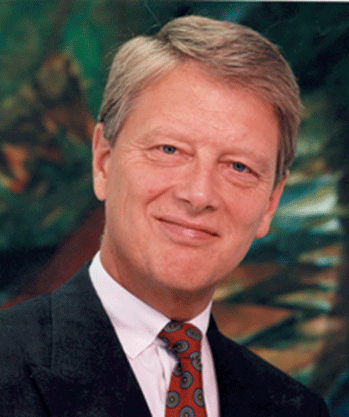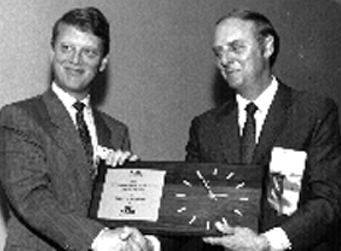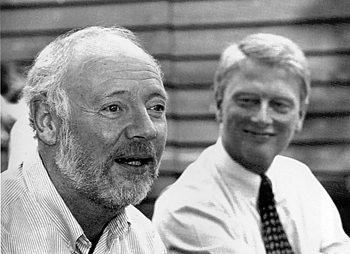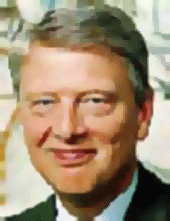I
Miss Jacques Ancher
Reporters Notebook:
 At
TIACA Amsterdam late night conversations turned to people we have known
over the years in the air cargo business. At
TIACA Amsterdam late night conversations turned to people we have known
over the years in the air cargo business.
Make no mistake about it: despite changes
felt in almost every quarter of the air cargo experience, this industry
is still all about people.
There have been a few people who have touched
almost every facet of air cargo, even impacting people in companies other
than their own.
As we sat thinking about these things in
Amsterdam, somebody started talking about mentors in the air cargo industry.
Then somebody mentioned Jacques Ancher.
I miss Jacques Ancher.
Jacques served a lifetime (38 years) in
transportation and at the point he retired in 1999, was Executive Vice-President
Cargo at KLM Royal Dutch Airlines.
Jacques Ancher was a visionary of the air
cargo business.
In fact, Jacques saw way beyond the horizon
when it came to anything connected to transportation.
He viewed air cargo and the entire logistics
exercise in clear and precise terms while others noticed little more than
a blur in the rearview mirror.
During his time, KLM operated a fleet of
cargo-friendly combi aircraft across its vast international route system,
offering main-deck capabilities almost everywhere the airline flew.
The airline also formed a holding company
and acquired the most advanced air cargo facilities while it moved to
secure European road feeder companies.
KLM brought on ACMI lift as an originator
of that form of transportation as it positioned itself as the undisputed
leader in several segments of air cargo, including live animal and perishables
transport.
The driving influence for much of this was
Jacques Ancher.
To be sure, KLM has always been a cargo
savvy airline.
In fact, the current and immediate past
chief executives of the carrier were both top cargo men at the airline
before landing behind the CEO’s desk.
| 
|
 |
Jacques Ancher brought focus,
vision and excitement to his airline and air cargo as well, saying this
in 1998:
“Essentially, each airline has a different
level of strategic importance regarding cargo; it is finding the common
ground when negotiating an alliance that takes time as each of the partners
have their own agenda.
“The future of air cargo is finding
the right strategic partners; the exclusivity of the partnership deal
will be negotiable based on competitive pressures and conflict of interest.
“Exclusive alliances will probably
dissolve during the next few years while the carrier looks to fill gaps
in its service network and more fluid arrangements are established.”
We remember Jacques as an amazingly well
rounded individual.
He enjoyed air cargo, thought of this business
as the art that it is, and celebrated KLM Cargo with a passion that eludes
most executives.
He also gave the reporter the best of all
possible worlds.
Jacques was an engaged and engaging personality,
who was always good copy.
He could sit for hours with a room full
of reporters in sessions of the world air cargo media at KLM Cargo headquarters.
In an era of quickie statements and sound
bites, when was the last time that happened anywhere?
It really didn’t matter if the gatherings
were about a product launch or facility dedication, issues came out on
the table and were confronted.
More often than not, what began as a media
event turned into a roundtable work session, a kind of “fetch-up
some deep thoughts and talk about them” encounter with the press.
Jacques would place his wristwatch alongside
his note pad at these gatherings because when the talk got going great,
time became a non-issue to Jacques.
But today, any trade show forum session
would do well to get a discussion going that even remotely matches the
dynamics of reality and substance that those KLM media sessions were during
the early 1990’s.
Jacques also enjoyed life, friends, good
food and wine.
Often, when it came to entertaining, Jacques
Ancher would pull out all the stops.
Once, after an all-day press session at
cargo headquarters in Amsterdam, Jacques hosted a dinner for about 100
members of the media and others. He hosted it at Huis Von Loon, a classic
Dutch double-sized canal house, which once belonged to one of Rembrandt’s
pupils and today is restored to its former elegance and is located in
the old part of Amsterdam on a narrow street and waterway called the Keizersgracht.
Dinner at small candle-lit tables was intimate,
excellently prepared and served with gaiety, élan, much laughter
and good conversation, followed by a scripted, light-hearted presentation
that included Jacques and members of the KLM Cargo team.
They just don’t do those kinds of
things around air cargo very much anymore.
My favorite Jacques Ancher encounter occurred
in 1995 while visiting KLM Cargo headquarters at Schiphol Airport.
I was in the VIP lav washing my hands, and
noticed Jacques standing next to me, doing the same thing.
For no particular reason, I began talking
about my desire to create an air cargo book series and how I had imagined
that KLM, with such a rich culture for cargo, would be an ideal start.
We talked in that small lavatory for 45
minutes; without interruption, we felt lost in time, and only exited after
we had shook hands, having decided to do the book.
Outside, a half dozen KLM’ers at HQ
were wondering whether they should break the door down.
I still remember the looks on those faces
as the top boss at KLM Cargo and the writer emerged from the executive
toilet after three quarters of an hour.
But that was Jacques.
No matter what else was going on, his thought
process was completely focused on what was at hand.
Like a great athlete, his concentration
was total.
For my brief encounter, I discovered that
working for him was a real treat.
I researched the pictures, designed the
book and wrote the copy from a base inside the legendary, granite, art
nouveau 1902 American Hotel, located near Leidse Square in Amsterdam.
The place was a constant charge to the creative
juices.
I worked all day in my room overlooking
the canal and drank all night in the hotel pub – The Nightwatch
Bar – talking to the locals while imagining Hemingway barreling
through a side door, slugging down a frosty tall Heineken, and disappearing
into the night.
Late one Friday afternoon, while awaiting
a plane back to New York City, I was sitting in what I thought was an
empty office up at KLM Cargo HQ, looking over some design sheets for the
book (True Blue—The History of KLM Cargo, 1996) when a soft, familiar
voice outside called out a name.
It was Jacques looking for somebody.
I bid him come inside the room and entreated
his patience to show him some of the stuff in the book, looking and hoping
for approval.
I read him the last page of the book, which
contained a picture of a small statue Jacques had commissioned for the
reception room downstairs by the elevator.
After describing the page and caption, he
said nothing.
Finally unable to stand it, I asked him
what he thought of the work and the last photo and caption, saying something
like:
 “You
can suggest something else.” “You
can suggest something else.”
He looked at me and said:
“I wouldn’t change anything.
“Your work is unique.
“You are an artist.”
I cannot describe the feeling at that moment
except to say that my desire to do books about the business I love was
touched four square and has been fueled ever since.
People that understand the human condition
and attempt to balance the big time business thing are rare; there are
a few who can do it.
Imagine an air cargo facility, among the
most advanced in the world, which also contains art commissioned by the
airline or company, affording artists a palette to create original works
that are presented in places of pride inside working areas and waiting
rooms?
Jacques Ancher left something else to air
cargo.
The last time we were there, the air cargo
facility located in the City of Amsterdam, home of Rembrandt and Van Gogh,
still supported and displayed original works created by unknown aspiring
artists commissioned by KLM from destinations the airline serves around
the world.
Jacques also saw to it that KLM created
the first leading edge, avant-garde publication for air cargo when KLM
Cargovision, a magazine house organ, was completely reformed during the
mid-1990s into a monthly work of art itself.
Many thought when Jacques Ancher retired,
he was too young to have left, and that he would probably pop up somewhere
later.
But apparently, Jacques Ancher really wanted
to study grandchildren and savor the wine of a life well lived.
He has repeatedly turned down interviews and “where is he now?”
type stories, preferring to stay at home or out on the beach enjoying
his family and life.
There is tremendous hope in the proposition
that there are among us well-ordered lives that continue after air cargo.
Still, I miss Jacques Ancher.
He was not just another suit in the executive
tier, but rather a great leader, thinker and patron of life to the air
cargo business.
To air cargo, Jacques Ancher was and is
the Dutch Master.
He also makes me feel glad that I lived
long enough to tell you this story.
Geoffrey Arend
Postscript: After completion of “True Blue” in late 1995
(first copies were published in 1996), I mostly forgot all about it except
to wonder if Jacques liked the work at completion, as much as he indicated
he had while the work was in progress.
After Jacques retired, somebody in mid-year
2000 from Delta Shuttle (which operates downstairs from our offices at
Marine Air Terminal-LaGuardia) knocked on the door of our office with
a four year-old DHL package from Netherlands with apologies that the parcel
had been put next to, and apparently fallen behind, a filing cabinet,
not to be discovered until some renovations on the office took place.
Inside the package was the best response
possible to our KLM Cargo book: a framed special recognition of thanks
from the great airline itself, signed by Jacques Ancher.
Edited by Flossie Arend |





 “You
can suggest something else.”
“You
can suggest something else.” 